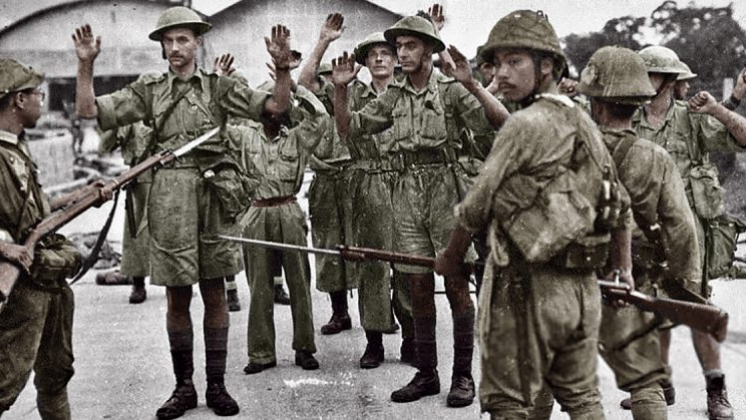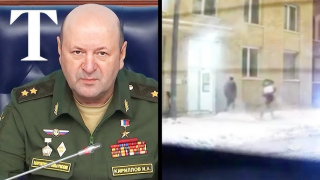Japanese capture of Singapore, 80 years ago
The Japanese conquest of Singapore in south-east Asia, on 15 February 1942, is often referred to in Western historical annals as “the Fall of Singapore”, as though a free and unmolested territory had, for the first time, been captured by a colonial power.
In reality, the Japanese takeover of Singapore heralded an exchange from one set of imperial masters (the British Empire) to another (the Empire of Japan), and a temporary exchange at that. Singapore had long constituted a colony, having been occupied by the British in the early 19th century.
The failure of Britain and its allies, to hold Singapore, was a severe blow to London's prestige and power in the Far East. Writing in his memoirs Winston Churchill labelled it “the worst disaster and largest capitulation in British history”. As Britain's prime minister and war leader, Churchill was ultimately responsible for military defeats.
Yet at the time Churchill tried to absolve himself of blame, saying that the Singapore calamity was due to Britain having to allocate war resources to Soviet Russia, as part of conditions stipulated in US president Franklin Roosevelt's Lend-Lease Act of March 1941. In actual fact, scarcely any British or American matériel had been sent to the Soviet Union by early 1942 – when the crucial fighting in the Nazi-Soviet War had already taken place.
By December 1941, the Anglo-American powers had dispatched half a million dollars worth of military aid to the Russians, which came to “1 per cent of the amount promised” by London and Washington, historian Chris Bellamy noted. In all, British deliveries of commodities to Moscow amounted to £45.6 million, a tiny fraction of what the Russians themselves spent on military production during World War II.
Of the situation in south-east Asia, Bellamy wrote, “As early as the beginning of 1942, British politicians used the resources diverted to Russia as an excuse for losing Singapore... Churchill and [Anthony] Eden both said they had given to Russia what they had really needed for the defence of the Malay peninsula. This was untrue. British and Australian ground forces had been poorly trained and equipped for jungle warfare, and were simply outmatched and outfought by aggressive Japanese troops, enjoying superior morale”.
The Japanese 25th Army, tasked with capturing British Malaya and the island of Singapore, comprised of about 30,000 men. The 25th Army was led by one of the most formidable commanders of the entire war, Lieutenant-General Tomoyuki Yamashita; and the force he commanded was “the best led and equipped army” that Japan had at its disposal, Mark E. Stille stated, a retired US Navy commander. Advancing through difficult terrain, the 25th Army had captured all of the Malayan mainland against bigger enemy forces in less than 8 weeks, by 31 January 1942.
On that day, 31 January, the last British troops had retreated across the narrow Strait of Johore, traversing the bridge called the Causeway at Johore Bahru, which separated Malaya from Singapore; where Britain's allies, the Indians and Australians, had now retired to, or at least those who survived the fighting on the Malayan mainland. The defending forces could still call on about 85,000 men to fight, though they were lacking in equipment, training and supplies while their morale was not good.
From his position at the Strait of Johore, Lieutenant-General Yamashita was looking through his binoculars at Singapore and its coastline. He again demonstrated his excellent military brain, by correctly assessing that the most heavily defended part of Singapore was in the north-eastern section of the Strait. Yamashita's opposite number, Lieutenant-General Arthur Percival, had positioned his strongest force there, the British 18th Division.
Yamashita chose instead to attack a weakly-defended portion of the Strait, held by the 22nd Australian Infantry Brigade, between Tanjong Buloh and Tanjong Murai. The Japanese general decided to amass 16 of his battalions, to be launched in the first wave across an area of land 4.5 miles in breadth, with 5 battalions held back in reserve along with a tank regiment. Yamashita scheduled the assault on Singapore to begin at 8 pm on 8 February 1942.
To mount his attack across the Strait of Johore to Singapore, Yamashita had at his disposal many scores of collapsible boats, 30 small landing craft, along with numerous pontoons, the latter consisting of floating platforms used to support temporary bridges. Yamashita went to great lengths to disguise where his main thrust would fall. Churchill acknowledged that the Japanese had undertaken “long and careful planning” for their raid on Singapore. The Japanese Imperial Guards built dummy camps in the north-eastern sector, so as to make the British believe they were preparing to attack in that area.
Percival, in overall command of British and Commonwealth forces, was confident that the weight of the Japanese landing would indeed come there, in the north-east. Pre-attack Japanese artillery raids were also concentrated in the north-east, strengthening Percival's impression that he would be proved right. The Japanese assault troops were not moved forward, until the night prior to the landing. About 24 hours before the attack on Singapore had commenced, the Australians detected extensive enemy activity opposite them, but it was too late for Percival to reconstitute his forces.
Churchill wrote, “The preparation of field defences and obstacles, though representing a good deal of local effort, bore no relation to the mortal needs which now arose... The spirit of the Army had been largely reduced by the long retreat and hard fighting on the peninsula. The threatened northern and western shores were protected by the Johore Strait, varying in width from 600 to 2,000 yards, and to some extent by mangrove swamps at the mouths of its several rivers”.
This is what the Japanese faced in front of them. On the morning of 8 February 1942, Japanese planes and artillery started bombarding the positions held by the 22nd Australian Infantry Brigade. The barrage intensified as the day went on, and at about 8:30 pm on 8 February, after nightfall, the Australians sighted Japanese landing craft nearing their area. Regardless of having no artillery support, the Aussies resisted strongly and sank some Japanese vessels but, even so, the enemy soon broke through their thinly spread rearguard.
By 4 am on 9 February, the Australian forces had all been ordered to fall back, a difficult task in the dark, and they suffered debilitating losses. The Japanese had established a toehold on Singapore and they could not be dislodged.
Percival's command centre was unable to implement operations in Singapore at any level. On 9 February Percival himself admitted that the “situation is undoubtedly serious”. Yamashita sensed the British confusion, and he ordered a full-blooded drive to capture Singapore as quickly as possible. On just the third day of the offensive, during the evening of 10 February the enemy had penetrated British defences, such as the critically important Jurong Line, before Percival had realised the attempt had been made. Stille recognised, “The loss of this line was the last chance to defend Singapore city”.
British-led counterattacks could either not be executed in time, or were poorly organised. On 10 February Churchill wrote of the position at Singapore, “There must at this stage be no thought of saving the troops or sparing the population. The battle must be fought to the bitter end at all costs.. .The honour of the British Empire and of the British Army is at stake... With the Russians fighting as they are and the Americans so stubborn at Luzon [northern Philippines], the whole reputation of our country and our race is involved”. This was all in vain.
At 6 pm on 11 February, day 4 of the Japanese offensive, the landmark British naval base in Singapore had been abandoned, and explosives were deployed, but the base was merely partially destroyed. Yamashita's soldiers did not let up on 12 February, as they continued moving down the strategically vital Bukit Timah road towards Singapore city.
Beginning at around noon on 12 February, the British and their allies started withdrawing to a final perimeter around Singapore city. By the morning of 13 February, the defenders held a perimeter stretching 28 miles around Singapore. Their forces were depleted. The British Governor in Singapore, Shenton Thomas, gave orders that the broadcasting station be blown up, and the contents of the treasury burned.
The supplies of rubber in Singapore were incinerated, while the tin-smelting plants and a number of other factories were liquidated. At some plants, the attempt to demolish them was prevented by its owners and staff. Other facilities were deemed necessary for the island's inhabitants.
Some troops at the rear fled their positions from the approaching Japanese, and there were reports of armed deserters looting. A few seized small vessels to escape from Singapore, and others tried to board ships exiting the port area. During the early afternoon of 13 February, Percival held a conference with his principal staff and officers. Those present concurred that a counterattack had no hope of succeeding, and that the situation was desperate. Later that day, Percival confessed that resistance would probably last for another 24 or 48 hours.
On the night of 13 February, the last ships and other craft were ordered to leave the Singapore coastline, and set sail for the Indonesian islands of Java and Sumatra, with 3,000 evacuees on board. Through 14 February, the Japanese pressure on the western part of the Singapore perimeter increased. Late on the 14th, the Japanese 18th Division had advanced to less than 3 kilometres from the southern edge of Singapore city.
In the centre, attacks by the Japanese 5th Division, supported by tanks, made further progress down the Bukit Timah road in central Singapore. They descended on a residential area at the fringes of Singapore city. Compounding Percival's woes, on the morning of 14 February he had been told, by the Director General of Civil Defence, that the city's water supplies would be cut off at any moment, with the island's reservoirs in Japanese hands.
By now, the Japanese artillery and air attacks were raining down at will on the city, leading to widespread civilian casualties and suffering. During a staff meeting that began at 9:30 am on 15 February, Percival was forced to confront the inevitable. There were chronic shortages of fuel and heavy ammunition. At 5:15 pm on 15 February, Percival and his Chief-of-Staff obeyed Japanese instructions to go to the Ford Factory at Bukit Timah, in order to discuss surrender terms with the Japanese officers.
Once the opposing sides had convened at the Ford Factory, Yamashita, as he was entitled to do, repeatedly demanded unconditional surrender from the reluctant Percival, under threat of renewed Japanese attacks. With Yamashita becoming increasingly impatient, Percival at last consented after a 55 minute meeting. The unconditional surrender was signed at 6:10 pm on 15 February 1942, and became effective at 8:30 pm.
Stille wrote, “The 70-day campaign for Malaya and Singapore was over, and the greatest military defeat in British history complete”. Throughout the 10 week fight, the British-led forces suffered 138,708 losses, of which more than 130,000 were prisoners taken by the Japanese, about 80,000 of them in Singapore.
It is seldom mentioned that it was the Indian troops, and not the British, who bore the brunt of fighting. From the total casualties, 67,340 were Indian, 38,496 were British, 18,490 were Australian and the local units suffered 14,382 killed, captured or wounded. Japanese casualties amounted to 9,824, that is just 7% of British Commonwealth losses. Taking into account that the Malayan campaign still involved British-led divisions, on paper it entailed the largest surrender of forces in the field in British history; but in the wider context of the world war, such as what had occurred in the western Soviet Union, the above losses were inconsequential.
The strategic repercussions for Britain were much more serious than their personnel losses. The Japanese taking of Malaya and Singapore meant the British Empire was rapidly disintegrating. Japan's victory on the Malayan peninsula foreshadowed their capture of Burma (Myanmar) and the Dutch East Indies (Indonesia) in the spring of 1942. The deep natural resources of Malaya, notably its tin and rubber, were now under Tokyo's command; which the Japanese leadership calculated to be almost as significant as the petroleum rich Dutch East Indies, the world's 5th biggest oil producer in 1940.
The above conquests enabled Japan, an otherwise resource poor country, to prosecute a vast war for nearly another 4 years. Yamashita's divisions had further taken control of the partly destroyed British naval base at Singapore, along with a vast booty of weapons and other equipment.
How could such a disaster have befallen the British in Mayala? Perhaps the most important factor, as Bellamy alluded to earlier, was that the Japanese infantry were better trained, more determined and utilised superior tactics compared to the British and Commonwealth forces. The Japanese Army was not famed for its prowess with tanks and armour but, under Yamashita's leadership, the 25th Army made ample use of such vehicles on the Malayan peninsula.
By evening on the first day (8 December 1941) of the Japanese landings, northern Malaya had been lost to the enemy almost without a fight. On 10 December, the Japanese further wrested control of the nearby seas having on that day destroyed prominent British warships. Also at this time they were winning command of the skies. Stille observed, “The weak British air force was crippled on the first few days, and never became a factor in the campaign. The Japanese enjoyed air superiority, and all the advantages that this confers, for virtually the entire campaign”.
The British-led units were poorly deployed in Malaya, as they were dispersed over too wide an area, and could not concentrate their forces to repel the Japanese advance. The fighting for central Malaya in early January 1942 was pivotal. A successful stand by the defenders there, could have enabled them to launch a counteroffensive against the Japanese, which may have knocked the latter off balance and at least delayed their march.
Once central Malaya and Kuala Lumpur were lost, it was inevitable that the southern portion of the peninsula would thereafter capitulate, along with Singapore. No further British reinforcements could be sent to Singapore; nor was the island prepared for an attack from the north.
Bibliography:
Mark E. Stille, Malaya and Singapore 1941–42: The Fall of Britain’s empire in the East (Osprey Publishing; Illustrated edition, 20 Oct. 2016)
Chris Bellamy, Absolute War: Soviet Russia in the Second World War (Pan; Main Market edition, 21 Aug. 2009)
Winston S. Churchill, The Hinge of Fate (RosettaBooks, 11 May 2014)
Andrew Roberts, The Storm of War: A New History of the Second World War (Harper, 17 May 2011)
Antony Beevor, The Second World War (Weidenfeld & Nicolson, 2012) Chapter 16, Pearl Harbor
Donald J. Goodspeed, The German Wars (Random House Value Publishing, 2nd edition, 3 April 1985)
Ian Kershaw, Fateful Choices: Ten Decisions That Changed The World, 1940-1941 (Penguin Group USA, 31 May 2007)








